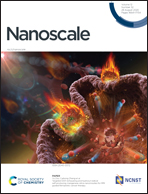Strongly coupled exciton–plasmon nanohybrids reveal extraordinary resistance to harsh environmental stressors: temperature, pH and irradiation†
Abstract
Hybridized plexcitonic states have unique properties which have been widely studied in recent decades in many research fields targeted at both fundamental science and innovative applications. However, to make these applications come true one needs to ensure the stabilization and preservation of electronic states and optical transitions in hybrid nanostructures, especially under the influence of external stressors, in regimes, that have not yet been comprehensively investigated. The present work shows that the nanohybrid system, composed of plasmonic nanoparticles and J-aggregates of organic molecules, displays outstanding resistance to harsh environmental stressors such as temperature, pH and strong light irradiation as well as demonstrates long-term stability and processability of the nanostructures both in weak and strong coupling regimes. These findings contribute to a deeper understanding of the physicochemical properties of plexcitonic nanoparticles and may find important implications for the development of potential applications in optoelectronics, optical imaging and chemo-bio-sensing and, in general, in the field of optical materials science.



 Please wait while we load your content...
Please wait while we load your content...